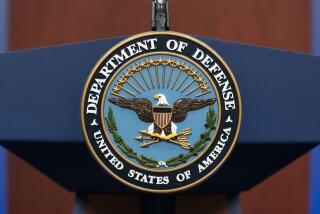Carrier Kitty Hawk Adds to U.S. Forces in Middle East
- Share via
WASHINGTON — In the latest sign of the unconventional campaign it is planning, the Pentagon on Monday dispatched a half-empty aircraft carrier to the Middle East to serve as a staging area for special operations units.
To transport the helicopters that carry such units, the aircraft carrier Kitty Hawk left a portion of its usual complement of 75 warplanes at its home port in Japan, officials said. The carrier may also be used as a launch area for Navy aircraft from other units.
Specially trained forces and elite light infantry units are expected to be instrumental in the effort to locate and strike Saudi-born extremist Osama bin Laden and his Al Qaeda terror network. Some units have already been reported deployed to the region, and others are believed to be on their way.
The dispatch of the half-empty Kitty Hawk “is a little unusual, but this war is a little unusual too,” said a defense official who asked to remain unidentified.
Another official noted, however, that aircraft carriers were used for a similar purpose in the 1994 U.S. military intervention in Haiti. In that operation, one carrier transported members of the Army’s 10th Mountain Division, and a second carried special operations personnel.
The Kitty Hawk is the fourth carrier heading to, or already in, the region, marking the largest concentration of carrier force since the Persian Gulf War 10 years ago.
Based in Yokosuka, Japan, the Kitty Hawk usually carries about half support aircraft and half attack planes. The attack planes are F-14 Tomcats and F/A-18 Hornets; the support aircraft include surveillance planes.
Officials said they left a mix of attack and support planes on the carrier.
Military officials stressed that even without the Kitty Hawk, they had more than enough planes for any strike mission the United States was likely to order soon.
Given the limited number of targets in Afghanistan, and the presence of more than 200 U.S. planes in the region, “it’s hard to imagine what we’d need more planes for,” said a defense official. “What’s the target?”
The Kitty Hawk, which is part of the U.S. 7th Fleet, had recently returned from nine days of exercises in the deep waters off Japan. Some observers speculated that the trip may have been intended to allow sailors and fighter pilots time to refresh their skills before they joined the anti-terrorist operation.
Of the 12 U.S. aircraft carriers, it is the only one permanently deployed outside U.S. territory, and its departure leaves East Asia without an American carrier.
A Navy spokesman said that the Kitty Hawk’s official mission was to “support efforts to identify, locate and hold accountable terrorists and those who support and harbor them.”
The spokesman declined to identify the carrier’s destination, but other officials said it was headed for the Arabian Sea. More than two dozen U.S. ships have already taken up positions between the Indian Ocean and the Red Sea.
The carriers Carl Vinson and Enterprise were in the region before the Sept. 11 attacks. A third carrier, the Theodore Roosevelt, is believed to be steaming across the Mediterranean and is also due to take part in the operation.
About 200 attack and support aircraft are deployed in Southwest Asia, as well as 29,000 U.S. troops. Part of the troops are in an Amphibious Ready Group of 2,100 Marines attached to the Vinson carrier battle group of ships.
Navy officials said the concentration of four carriers and dozens of other ships in one region would not cause undue stress on the Navy in the short term.
But outside analysts noted that if such deployments are continued over time, they would disrupt training and personnel rotations .
There were also reports of U.S. forces moving into Uzbekistan, which has been repeatedly mentioned as a staging ground for U.S. forces entering Afghanistan from the north.
Russian television reported that a U.S. C-130 Hercules transport had landed at Khanabad, an air base about 250 miles southwest of Tashkent, Uzbekistan. U.S. officials and officials of the Uzbekistan Defense Ministry declined to comment.
President Bush hailed the progress of the military buildup. In remarks at the Federal Emergency Management Agency in Washington, he noted that thousands of U.S. troops and “several hundred” U.S. aircraft had reached Southwest Asia. “On the military front, we’re making progress,” he said.
More to Read
Sign up for Essential California
The most important California stories and recommendations in your inbox every morning.
You may occasionally receive promotional content from the Los Angeles Times.











